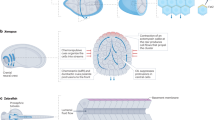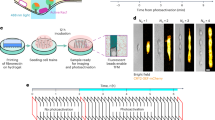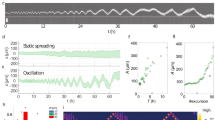Abstract
Fundamental biological processes including morphogenesis, tissue repair and tumour metastasis require collective cell motions1,2,3, and to drive these motions cells exert traction forces on their surroundings4. Current understanding emphasizes that these traction forces arise mainly in ‘leader cells’ at the front edge of the advancing cell sheet5,6,7,8,9. Our data are contrary to that assumption and show for the first time by direct measurement that traction forces driving collective cell migration arise predominately many cell rows behind the leading front edge and extend across enormous distances. Traction fluctuations are anomalous, moreover, exhibiting broad non-Gaussian distributions characterized by exponential tails10,11,12. Taken together, these unexpected findings demonstrate that although the leader cell may have a pivotal role in local cell guidance, physical forces that it generates are but a small part of a global tug-of-war involving cells well back from the leading edge.
This is a preview of subscription content, access via your institution
Access options
Subscribe to this journal
Receive 12 print issues and online access
$259.00 per year
only $21.58 per issue
Buy this article
- Purchase on SpringerLink
- Instant access to full article PDF
Prices may be subject to local taxes which are calculated during checkout




Similar content being viewed by others
References
Lecaudey, V. & Gilmour, D. Organizing moving groups during morphogenesis. Curr. Opin. Cell Biol. 18, 102–107 (2006).
Martin, P. & Parkhurst, S. M. Parallels between tissue repair and embryo morphogenesis. Development 131, 3021–3034 (2004).
Friedl, P. & Wolf, K. Tumour-cell invasion and migration: Diversity and escape mechanisms. Nature Rev. Cancer 3, 362–374 (2003).
du Roure, O. et al. Force mapping in epithelial cell migration. Proc. Natl Acad. Sci. USA 102, 2390–2395 (2005).
Vaughan, R. B. & Trinkaus, J. P. Movements of epithelial cell sheets in vitro. J. Cell Sci. 1, 407–413 (1966).
Omelchenko, T. et al. Rho-dependent formation of epithelial ‘leader’ cells during wound healing. Proc. Natl Acad. Sci. USA 100, 10788–10793 (2003).
Friedl, P., Hegerfeldt, Y. & Tusch, M. Collective cell migration in morphogenesis and cancer. Int. J. Dev. Biol. 48, 441–449 (2004).
Gov, N. S. Collective cell migration patterns: Follow the leader. Proc. Natl Acad. Sci. USA 104, 15970–15971 (2007).
Poujade, M. et al. Collective migration of an epithelial monolayer in response to a model wound. Proc. Natl Acad. Sci. USA 104, 15988–15993 (2007).
Liu, C. H. et al. Force fluctuations in bead packs. Science 269, 513–515 (1995).
O’Hern, C. S., Langer, S. A., Liu, A. J. & Nagel, S. R. Force distributions near jamming and glass transitions. Phys. Rev. Lett. 86, 111–114 (2001).
Ostojic, S., Somfai, E. & Nienhuis, B. Scale invariance and universality of force networks in static granular matter. Nature 439, 828–830 (2006).
Lauffenburger, D. A. & Horwitz, A. F. Cell migration: A physically integrated molecular process. Cell 84, 359–369 (1996).
Keren, K. et al. Mechanism of shape determination in motile cells. Nature 453, 475–480 (2008).
Hu, K. et al. Differential transmission of actin motion within focal adhesions. Science 315, 111–115 (2007).
Giannone, G. et al. Lamellipodial actin mechanically links myosin activity with adhesion-site formation. Cell 128, 561–575 (2007).
Beningo, K. A. et al. Nascent focal adhesions are responsible for the generation of strong propulsive forces in migrating fibroblasts. J. Cell Biol. 153, 881–888 (2001).
Dembo, M. & Wang, Y. L. Stresses at the cell-to-substrate interface during locomotion of fibroblasts. Biophys. J. 76, 2307–2316 (1999).
Montell, D. J. Morphogenetic cell movements: Diversity from modular mechanical properties. Science 322, 1502–1505 (2008).
Matsubayashi, Y., Ebisuya, M., Honjoh, S. & Nishida, E. ERK activation propagates in epithelial cell sheets and regulates their migration during wound healing. Curr. Biol. 14, 731–735 (2004).
Bindschadler, M. & McGrath, J. L. Sheet migration by wounded monolayers as an emergent property of single-cell dynamics. J. Cell Sci. 120, 876–884 (2007).
Holmes, S. J. The behaviour of the epidermis of amphibians when cultivated outside the body. J. Exp. Zool. 17, 281–295 (1914).
Hutson, M. S. et al. Forces for morphogenesis investigated with laser microsurgery and quantitative modeling. Science 300, 145–149 (2003).
Farooqui, R. & Fenteany, G. Multiple rows of cells behind an epithelial wound edge extend cryptic lamellipodia to collectively drive cell-sheet movement. J. Cell Sci. 118, 51–63 (2005).
Butler, J. P., Tolic-Norrelykke, I. M., Fabry, B. & Fredberg, J. J. Traction fields, moments, and strain energy that cells exert on their surroundings. Am. J. Physiol. Cell Physiol. 282, C595–C605 (2002).
Sabass, B., Gardel, M. L., Waterman, C. M. & Schwarz, U. S. High resolution traction force microscopy based on experimental and computational advances. Biophys. J. 94, 207–220 (2008).
Del Alamo, J. C. et al. Spatio-temporal analysis of eukaryotic cell motility by improved force cytometry. Proc. Natl Acad. Sci. USA 104, 13343–13348 (2007).
Merkel, R., Kirchgessner, N., Cesa, C. M. & Hoffmann, B. Cell force microscopy on elastic layers of finite thickness. Biophys. J. 93, 3314–3323 (2007).
Fenteany, G., Janmey, P. A. & Stossel, T. P. Signaling pathways and cell mechanics involved in wound closure by epithelial cell sheets. Curr. Biol. 10, 831–838 (2000).
Goffin, J. M. et al. Focal adhesion size controls tension-dependent recruitment of alpha-smooth muscle actin to stress fibers. J. Cell Biol. 172, 259–268 (2006).
Saez, A., Buguin, A., Silberzan, P. & Ladoux, B. Is the mechanical activity of epithelial cells controlled by deformations or forces? Biophys. J. 89, L52–L54 (2005).
Gov, N. S. Modeling the size distribution of focal adhesions. Biophys. J. 91, 2844–2847 (2006).
Zegers, M. M. et al. Pak1 and PIX regulate contact inhibition during epithelial wound healing. EMBO J. 22, 4155–4165 (2003).
Shraiman, B. I. Mechanical feedback as a possible regulator of tissue growth. Proc. Natl Acad. Sci. USA 102, 3318–3323 (2005).
Van Hecke, M. Granular matter: A tale of tails. Nature 435, 1041–1042 (2005).
Coppersmith, S. N. et al. Model for force fluctuations in bead packs. Phys. Rev. E 53, 4673–4685 (1996).
Wang, N. et al. Cell prestress. I. Stiffness and prestress are closely associated in adherent contractile cells. Am. J. Physiol. Cell Physiol. 282, C606–C616 (2002).
Yeung, T. et al. Effects of substrate stiffness on cell morphology, cytoskeletal structure, and adhesion. Cell. Motil. Cytoskeleton 60, 24–34 (2005).
Gui, L. & Wereley, S. T. A correlation-based continuous window-shift technique to reduce the peak-locking effect in digital PIV image evaluation. Exp. Fluids 32, 506–517 (2002).
Acknowledgements
We thank N. Gavara, R. Sunyer and C. Y. Park for experimental support and D. Tschumperlin and members of the Fredberg laboratory for insightful discussions.
Author information
Authors and Affiliations
Contributions
X.T., J.P.B. and J.J.F. designed research. X.T. and M.R.W. carried out experiments. J.P.B and X.T conducted theoretical analysis. T.E.A., D.A.W. and E.M. contributed to design protocols and data interpretation. X.T., J.P.B. and J.J.F. wrote the manuscript. J.P.B. and J.J.F. oversaw the project.
Corresponding authors
Supplementary information
Supplementary Information
Supplementary Information (PDF 560 kb)
Supplementary Information
Supplementary Movie 1 (MOV 2870 kb)
Supplementary Information
Supplementary Movie 2 (MOV 1900 kb)
Rights and permissions
About this article
Cite this article
Trepat, X., Wasserman, M., Angelini, T. et al. Physical forces during collective cell migration. Nature Phys 5, 426–430 (2009). https://doi.org/10.1038/nphys1269
Received:
Accepted:
Published:
Issue date:
DOI: https://doi.org/10.1038/nphys1269
This article is cited by
-
Role of viscoelasticity in the appearance of low-Reynolds turbulence: considerations for modelling
Journal of Biological Engineering (2024)
-
Cells play tug-of-war to start moving collectively
Nature Physics (2024)
-
Membrane to cortex attachment determines different mechanical phenotypes in LGR5+ and LGR5- colorectal cancer cells
Nature Communications (2024)
-
How multiscale curvature couples forces to cellular functions
Nature Reviews Physics (2024)
-
Field Guide to Traction Force Microscopy
Cellular and Molecular Bioengineering (2024)



